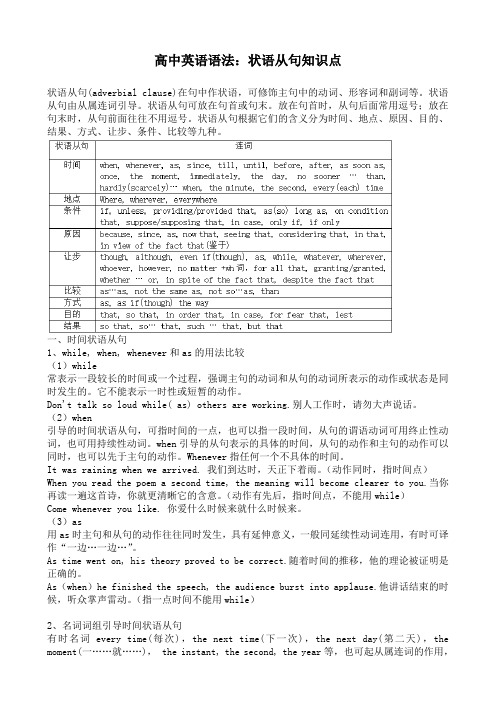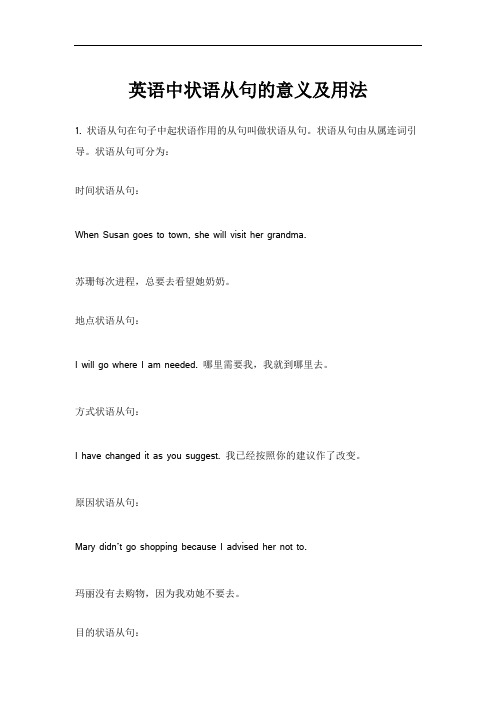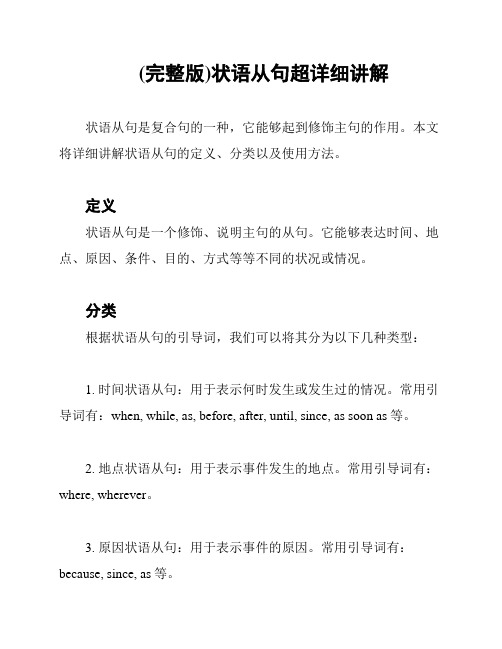状语从句按其意义和作用的划分
状语从句的分类与使用技巧

状语从句的分类与使用技巧状语从句是句子中充当状语的从句,通过修饰主句的谓语动词、形容词或副词,增强句子的表达效果,使语句更加丰富多样。
在英语写作中,灵活运用状语从句可以提升文章的流畅度和表达能力。
本文将介绍状语从句的分类和使用技巧。
一、状语从句的分类状语从句可以根据其所表达的具体含义分为时间状语从句、地点状语从句、原因状语从句、条件状语从句和结果状语从句等。
1. 时间状语从句时间状语从句用来表示主句的动作发生的时间。
常见的引导词有when(当)、while(当……的时候)、before(在……之前)、after (在……之后)等。
例如:- I will go to bed when I finish my homework.(当我完成作业时,我会去睡觉。
)- He always listens to music while he is jogging.(他跑步时总是听音乐。
)2. 地点状语从句地点状语从句用来表示主句的动作发生的地点。
常见的引导词有where(在哪里)、wherever(无论在哪里)等。
例如:- She will meet you where we agreed.(她会在我们约定的地方和你见面。
)- You can go wherever you like.(你可以去你喜欢的地方。
)3. 原因状语从句原因状语从句用来表示主句发生的原因。
常见的引导词有because (因为)、since(因为)、as(因为)等。
例如:- I couldn't go to the party because I was sick.(我因为生病不能去参加派对。
)- Since it's raining, we should stay at home.(因为下雨了,我们应该呆在家里。
)4. 条件状语从句条件状语从句用来表示主句发生的条件。
常见的引导词有if(如果)、unless(除非)等。
状语从句的种类与用法总结

状语从句的种类与用法总结状语从句是在复合句中,作为主句中的一个成分,用来修饰或限制主句的动词、形容词、副词等成分。
状语从句分为时间状语从句、原因状语从句、条件状语从句、目的状语从句、结果状语从句、让步状语从句等几种类型。
下面将对这些状语从句的特点和用法进行总结。
1. 时间状语从句时间状语从句用来表示动作发生的时间,可以分为过去、现在和将来几个方面。
常见的引导词有when, while, as, before, after, since, until 等。
例如:- I will go to bed after I finish my homework.(当我完成作业之后,我会去睡觉。
)- She always looks happy when she sees her friends.(当她见到她的朋友时,她总是看起来很开心。
)2. 原因状语从句原因状语从句用来表示动作的原因,常见的引导词有because, since, as等。
例如:- He didn't attend the meeting because he was sick.(因为他生病了,所以他没有参加会议。
)- Since it is raining outside, we should bring an umbrella.(因为外面在下雨,所以我们应该带把伞。
)3. 条件状语从句条件状语从句用来表示某种条件下会发生的情况,常见的引导词有if, unless, provided that等。
例如:- If it rains tomorrow, we will stay at home.(如果明天下雨,我们会呆在家里。
)- You can go out unless it is too hot.(除非天气太热,你可以出去。
)4. 目的状语从句目的状语从句用来表示主句的动作是为了实现从句中的目的,常见的引导词有so that, in order that等。
状语从句

8.由as long as和so long as 引导的时间状语从句。这两个连词表示 “有多久……就多久”,通常译为“只 要”。 你可以随意到哪里去,只要在天黑以前回 来就行。 You can go where you like as long as you get back before dark. I will fight against these conditions as long as there is a breath in my body! 只要我一息尚存,我就要反对这种境况。
7.由each time, every time和whenever Each time he came to Harbin, he would call on me. 他每次来哈尔滨,总是来看我。 Whenever that man says“To tell the truth”, I suspect that he's about to tell a lie. 每当那个人说“说实在话”的时候,我猜想 他就要说谎了。 You grow younger every time I see you. 每次遇到你,见你更年轻了。
I worked until he came back. 我工作到他回来为止。 I didn't work until he came back. 他回来我这才开始工作。
4.由since引导的时间状语从句。 since引导的从句的谓语动词可以是延续性 的动词,又可以是瞬时动词。一般情况下, 从句谓语动词用一般过去时,而主句的谓 语动词用现在完成时。但在It is +时间+ since从句的句型中,主句多用一般现在时。 自从你离开以来,我一直在北京了。 I have been in Beijing since you left. 我妹妹不在北京住有四年了。 It is four years since my sister lived in Beijing.
状语从句的种类及其在句子中的作用

状语从句的种类及其在句子中的作用状语从句是指在复合句中充当状语的从句,它可以修饰主句的动词、形容词、副词,从而进一步明确句子的意义。
状语从句通常由连词引导,根据其用途和从属关系的不同,可以分为多种类型。
本文将介绍状语从句的主要种类及其在句子中的作用。
一、时间状语从句时间状语从句是用来表示主句中动作或状态发生的时间。
常见的引导词有when(当)、before(在……之前)、after(在……之后)、while(当……时候)等。
例如:- When I arrived at the station, the train had already left.- Before he went to bed, he finished his homework.- After they had dinner, they went for a walk together.- While I was reading a book, my phone rang.时间状语从句可以帮助我们描述事件发生的先后顺序,使句子更加具体明确。
二、地点状语从句地点状语从句用来表示主句中动作的发生地点。
常用的引导词包括where(在哪里)、wherever(无论在哪里)等。
例如:- I will meet you where we agreed.- Wherever he goes, he always carries a book with him.地点状语从句可以提供更多的信息,使句子更加具体生动。
三、条件状语从句条件状语从句用来表示主句中动作发生的条件。
常见的引导词有if (如果)、unless(除非)、provided that(只要)等。
例如:- If it rains tomorrow, we will stay at home.- Unless you study hard, you won't pass the exam.- Provided that you finish your work on time, you can go out and play.条件状语从句可以表达假设、推理和条件之间的关系,使句子更加有逻辑性。
状语从句的分类及其在句子中的作用

状语从句的分类及其在句子中的作用状语从句是复合句中的一种从句类型,用来修饰、限制或补充主句的动作、状态、时间、地点等信息。
状语从句通常由一个连词引导,根据引导词的不同可以分为多种类型。
本文将介绍状语从句的分类以及它们在句子中的作用。
一、时间状语从句时间状语从句用来表示一个动作或事件发生的时间,常用的引导词有when(当...时候)、while(当...的时候)、as(一边...一边)、before(在...之前)、after(在...之后)等。
例如:I will go to bed when I finish my homework.(当我完成作业时,我会去睡觉。
)We were walking in the park while it was raining.(下雨的时候,我们在公园散步。
)时间状语从句可以帮助读者更清楚地理解动作发生的时间,使句子的句义更加完整。
二、地点状语从句地点状语从句用来表示一个动作或事件发生的地点,常用的引导词有where(在哪里)、wherever(无论在哪里)等。
例如:I will meet you where we had dinner last night.(我会在我们昨晚吃饭的地方见你。
)He can find his keys wherever he left them.(无论他把钥匙放在哪里,他都能找到。
)地点状语从句可以补充和修饰动作发生的地点细节,让读者更加具体地理解句子。
三、原因状语从句原因状语从句用来表示一个动作或事件的原因,常用的引导词有because(因为)、since(因为)、as(因为)等。
例如:She couldn't come to the party because she had to work.(她不能来参加派对,因为她要工作。
)Since it is raining, we will stay at home.(因为下雨,我们会待在家里。
状语从句的种类和状语从句在句子中的位置和作用

状语从句的种类和状语从句在句子中的位置和作用状语从句是汉语中一种常见的从句类型,它在句子中作为状语,用来修饰谓语动词、形容词、副词等成分。
本文将探讨状语从句的种类以及在句子中的位置和作用。
一、状语从句的种类1. 时间状语从句时间状语从句表示动作或事件发生的时间,它通常由引导词“当、一……就、每当、随着、直到、等等”引导。
例如:“每当我看到那部电影,我就会想起童年的回忆。
”2. 地点状语从句地点状语从句表示动作或事件发生的地点,通常由引导词“在哪里、到哪里、从哪里”引导。
例如:“我们可以到公园里玩耍,那里有许多游乐设施。
”3. 原因状语从句原因状语从句表示动作或事件发生的原因,通常由引导词“因为、由于、既然、假如、只要”引导。
例如:“由于下雨了,所以我们不能去露营。
”4. 条件状语从句条件状语从句表示在满足某种条件下才能实现的动作或事件,通常由引导词“如果、假设、只要、倘若”引导。
例如:“如果明天不下雨,我们就去郊游。
”5. 方式状语从句方式状语从句表示动作或事件发生的方式,通常由引导词“怎样、如何、以什么方式”引导。
例如:“他告诉我怎样去学好英语。
”6. 目的状语从句目的状语从句表示为了实现某种目的而进行的动作或事件,通常由引导词“为了、以便、以免”引导。
例如:“为了保持健康,我们每天都要锻炼身体。
”7. 结果状语从句结果状语从句表示动作或事件所导致的结果,通常由引导词“以致、结果、以至于”引导。
例如:“他没有努力学习,以致考试没考好。
”二、状语从句在句子中的位置和作用状语从句可以出现在句子的不同位置,并且在句子中起到不同的作用。
1. 位于句首当状语从句位于句子的开头时,它通常用逗号与主句隔开。
这种位置让状语从句在句子中起到强调的作用。
例如:“只要努力,就会成功。
”2. 位于句中当状语从句位于句子中间时,它往往用逗号或者连词与主句连接在一起。
这种位置可以提供更多的细节信息,增强句子的表达能力。
例如:“我会一直陪伴你,直到你痊愈。
状语从句的分类和用法

状语从句的分类和用法状语从句是指在复合句中充当状语的从句,用来修饰主句中的动作或描述情况。
状语从句的使用能够丰富句子结构,使语言表达更加准确和生动。
本文将介绍状语从句的分类和用法。
一、状语从句的分类根据状语从句与主句之间的关系不同,状语从句可以分为时间状语从句、条件状语从句、原因状语从句、结果状语从句和让步状语从句等几种。
1. 时间状语从句时间状语从句用来表示动作发生的时间或频率,常见的引导词有when(当...时候)、while(当...的时候)、before(在...之前)、after (在...之后)等等。
例如:He called me when he arrived at the station.(他到达车站的时候给我打电话。
)2. 条件状语从句条件状语从句用来表示发生某种条件时的结果,常见的引导词有if (如果)、unless(除非)、in case(以防)、as long as(只要)等等。
例如:If it rains tomorrow, we will stay at home.(如果明天下雨,我们会呆在家里。
)3. 原因状语从句原因状语从句用来表示某个行为或情况的原因,常见的引导词有because(因为)、since(因为)、as(由于)、for(因为)等等。
例如:He couldn't come to the party because he was sick.(他因为生病不能来参加派对。
)4. 结果状语从句结果状语从句用来表示某个行为或情况的结果,常见的引导词有so...that(如此...以至于)、such...that(如此...以至于)、so that(以便)、such that(以便)等等。
例如:She studied hard so that she could pass the exam.(她努力学习以便能够通过考试。
)5. 让步状语从句让步状语从句用来表示与主句相对立的情况,常见的引导词有although(虽然)、though(虽然)、even though(即使)、while(尽管)等等。
高考英语答题技巧 意思相似的词怎么选

高考英语答题技巧意思相似的词怎么选来源:《求学》杂志在高考英语考试中,难免会遇到一些选择题,选项意思相近,不知道如何下手。
小编分享解答这类题的技巧给大家,帮助大家在遇到词义相似的词时,做出正确的选择。
状语从句,顾名思义是在句中作状语的从句,修饰主句中的动词、形容词或副词等,有时修饰整个主句。
状语从句按其意义和作用可分为时间、条件、原因、让步、目的、结果、方式、比较、地点等,不同的状语从句的引导词或连词也有所不同。
此外,同一种意思的状语从句往往会有几个相似或相近的引导词来引导。
因此,正确区别相似或相近的引导词就显得尤为重要。
(一)引导时间状语从句的连词的选择引导时间状语从句的连词有:when, while, as, before, after, since,till/until, once, as soon as, the moment, the minute, immediately, directly,each/every time, the first time, the last time, next time, by the time, whenever 等。
其中我们要注意区别以下几组表时间的连词的选择:1.when, while, as表一:when, while, as的区别【例1】—I’m going to the post office.—_______ you’re there, can you get me some stamps?A. AsB. WhileC. BecauseD. If答案:B.点拨:此题容易误选A.尽管 as 和 while 均可用作从属连词引导时间状语从句,表示“当……的时候”,但此时 as 引导的从句的谓语不能是状态动词(英语中,除be动词之外,还有许多表示状态的特征、存在和变化的连系动词。
get, become,grow,turn,come,go,fall以及run,wear,make等动词能够表达“成为”“变成”等意义,即表示状态的变化。
高中英语语法:状语从句知识点

高中英语语法:状语从句知识点状语从句(adverbial clause)在句中作状语,可修饰主句中的动词、形容词和副词等。
状语从句由从属连词引导。
状语从句可放在句首或句末。
放在句首时,从句后面常用逗号;放在句末时,从句前面往往不用逗号。
状语从句根据它们的含义分为时间、地点、原因、目的、结果、方式、让步、条件、比较等九种。
一、时间状语从句1、while, when, whenever和as的用法比较(1)while常表示一段较长的时间或一个过程,强调主句的动词和从句的动词所表示的动作或状态是同时发生的。
它不能表示一时性或短暂的动作。
Don't talk so loud while( as) others are working.别人工作时,请勿大声说话。
(2)when引导的时间状语从句,可指时间的一点,也可以指一段时间,从句的谓语动词可用终止性动词,也可用持续性动词。
when引导的从句表示的具体的时间,从句的动作和主句的动作可以同时,也可以先于主句的动作。
Whenever指任何一个不具体的时间。
It was raining when we arrived. 我们到达时,天正下着雨。
(动作同时,指时间点)When you read the poem a second time, the meaning will become clearer to you.当你再读一遍这首诗,你就更清晰它的含意。
(动作有先后,指时间点,不能用while)Come whenever you like. 你爱什么时候来就什么时候来。
(3)as用as时主句和从句的动作往往同时发生,具有延伸意义,一般同延续性动词连用,有时可译作“一边…一边…”。
As time went on, his theory proved to be correct.随着时间的推移,他的理论被证明是正确的。
As(when)he finished the speech, the audience burst into applause.他讲话结束的时候,听众掌声雷动。
初中英语语法—状语从句

状语从句
【时间状语从句】
语法导学
1.时间状语从句: 5)由since,as soon as 引导。
状语从句在主句之前时一般用逗号与主句分开,如从句在主句 之后则不必用标点符号。
如: Great changes have taken place in China since 1978.
状语从句
【结果状语从句】
语法导学
5.结果状语从句: 2)由such…that引导。 such…that 的 such 后面跟名词,如果名词是单数 就要用such a /an…that, 还可以转换用so…that, 语气较强。 如:
We shall go there when we are free.
状语从句
【时间状语从句】
语法导学
1.时间状语从句: 2)由while,as 引导。
while指“在某一段时间里”,“在…期间”,while引导的动 作必须是持续性的。
as引导持续性动作,强调主句和从句的动作同时发生,从句 常译作“一边…一边…”。
如:The film had been on when we arrived.
My mother was cooking while I was doing my homework . As I left the house ,I forget the key.
状语从句
【时间状语从句】
语法导学
1.时间状语从句: 3)由before,after 引导。 before表示在…之前。 after译为“在…之后”。 如: Be a pupil before you become a teacher. He arrived after the game started.
高中英语语法系统讲解之十一状语从句

状语从句状语从句在句中作状语,修饰主句中的动词、形容词或副词等,有时修饰整个主句。
状语从句放在主句之前时,常用逗号分开;放在主句之后,一般不用逗号。
状语从句按其意义和作用分为时间、条件、原因、让步、目的、结果、方式、比较、地点等9种。
1. 时间状语从句时间状语从句可放在句首、句中或句尾。
常用when,while,as,after,before,since,until,once,as soon as,the minute / moment“一……就……”,hardly … when,no sooner …than“刚……就……”等连接词引导。
○1连词when,while,as都表示“当……的时候”,但是when引导的从句的动作和主句的动作可以同时发生,也可以先后发生;用as,while时则强调主句和从句的动作同时发生。
如While I was reading, he came in.As he walked along the street, he sang happily.但当从句表示“随时间推移”时,只能用连词as,不能用when或while。
如As time goes on, I like to speak English more and more.○2从属连词as soon as,immediately,directly,the moment,the minute,no sooner … than …,hardly / scarcely … when …,once引导的从句都表示从句的动作一发生,主句的动作随即就发生,意为“一……就……”,从句中用一般时态代替将来时态。
如Once you remember it, you’ll never forget it.The moment I heard the voice, I knew father was coming.No sooner had we arrived at the station than the train left.温馨提示:as soon as,the moment引导的从句表示“一……就……”;no sooner … than …,hardly … when引导的从句表示“刚……就……”。
状语从句详解

状语从句详解状语从句是复句中的一种从句,用来修饰动词、形容词、副词或整个句子。
它起到进一步说明、补充或限制主句的作用。
本文将详细解析状语从句的定义、分类、用法及注意事项。
一、状语从句的定义状语从句是一个从属分句,由连词引导,在主从句之间建立一种从属关系。
它通常修饰动词、形容词、副词或整个句子,用来表示时间、条件、原因、目的、方式、程度、比较等等。
通过引导词的不同,状语从句可以分为多种类型。
二、状语从句的分类1. 时间状语从句时间状语从句用来表示动作发生的时间,在主句中起到修饰的作用。
时间状语从句常用的引导词有:when(当)、while(当...时)、before (在...之前)、after(在...之后)、as(当...的时候)等等。
例如:- I will call you when I arrive home.(我到家后会给你打电话。
)- They went to bed after they finished their homework.(他们做完作业后就上床睡觉了。
)2. 条件状语从句条件状语从句用来表示主句发生的条件,在主句中起到修饰的作用。
条件状语从句常用的引导词有:if(如果)、unless(除非)、provided that(只要)、as long as(只要)等等。
例如:- If it rains, we will stay at home.(如果下雨,我们将待在家里。
)- You can go out unless it is too cold.(除非天气太冷,你可以出去。
)3. 原因状语从句原因状语从句用来表示主句发生的原因,在主句中起到修饰的作用。
原因状语从句常用的引导词有:because(因为)、since(因为)、as (因为)、for(因为)等等。
例如:- She didn't come to the party because she was sick.(她没有来参加聚会,因为她生病了。
广东中考语法专题:状语从句

状语从句
状语从句的定义及分类: 状语是用于说明地点、时间、原因、目的、结果、条件、程度、方式和伴随状况等的一种句法
成份. 用来修饰主句中的动词,副词和形容词的从句叫状语从句。根据其含义状语从句可分为:时间
状语从句,地点状语从句,条件状语从句, 原因状语从句,结果状语从句,比较状语从句,目的 状语从句,让步状语从句。
A. When
B. Whenever
C. Once
D. while
( ) 5. I remembered you ________ I saw you at the airport.
A. the moment B. while
C. after
D. before
( ) 6. He was about to go to bed ________ the doorbell rang.
【对点练习】
( ) 1. It was quiet ________ those big trucks started coming through the town.
A. before
B. after
C. until
D. when
( ) 2. It seemed only seconds ________ the boy finished washing his face.
A. while
B. as
C. when
D. after
( ) 7.________I listen to your advice, I get into trouble.
A. Every time
B. When
C. While
D. until
( ) 8. _____ John was watching TV, his wife was cooking.
状语从句分类

状语从句分类从句是汉语句子中的重要成分,而状语从句是构成句子表达意思的重要部分。
根据不同的功能,状语从句可以分成时间状语从句、地点状语从句、原因状语从句、让步状语从句、条件状语从句、目的状语从句和结果状语从句等几类。
一、时间状语从句时间状语从句是以时间意义为主要内容的状语从句。
它可以用来表示完成时状语从句,表示过去发生的动作;也可以用来表示一般现在时状语从句,指示发生的动作处于什么时候;还可以用来表示将来时状语从句,指明发生动作的时间。
例如:(1)我们每天早上九点钟起床。
(2)他现在正在制作一份计划书。
(3)明天小王考试,他一定会认真复习的。
二、地点状语从句地点状语从句是以地点意义为主要内容的状语从句。
它可以用来表示活动在哪里进行,具体地点由哪里所确定。
例如:(1)他们在家里开会。
(2)我们将去野营。
三、原因状语从句原因状语从句是表示原因的从句,它的作用是表示所叙述的事情背后的原因。
它是由“因为”、“由于”、“出于”等连接副词引导的从句。
例如:(1)因为下雨,所以今天不上学。
(2)由于他病了,所以不能参加比赛。
四、让步状语从句让步状语从句是表示让步关系的从句,它用以表示其前后句子之间的关系。
它是以“尽管”、“虽然”、“即使”等连接副词引导的从句。
例如:(1)尽管他知道这项工作很艰苦,但他还是已经接受了。
(2)虽然它的价格不菲,但消费者仍然愿意购买它。
五、条件状语从句条件状语从句是表示条件关系的从句,它用以表示某种情况或条件下才会发生或实现某种动作。
它是以“如果”、“假如”等连接副词引导的从句。
例如:(1)如果你早睡觉,就会感觉精力充沛。
(2)假如你能够把这个英文单词记住,你就可以写出一篇漂亮的作文了。
六、目的状语从句目的状语从句是表示目的关系的从句,它的作用是表示一定的动作是为了达到什么目的。
它是以“为了”、“以便”等连接副词引导的从句。
例如:(1)小明今天拒绝了其他人的邀约,为了专心准备明天的考试。
状语从句的引导词和结构

状语从句的引导词和结构状语从句是复合句中的一种从句,用来修饰主句中的动词、形容词、副词或者整个句子。
它通过引导词将从句和主句连接起来,起到修饰、限制或者说明的作用。
本文将详细介绍状语从句的引导词和结构。
一、引导词的种类状语从句的引导词根据其含义和功能可以分为不同的种类,下面是其中常见的几种:1. 时间状语从句引导词:when(当...时候)、before(在...之前)、after(在...之后)、while(当...的时候)等。
例如:- When I arrived at the airport, the flight had already taken off.- After he finished his work, he went home.2. 地点状语从句引导词:where(在哪里)、wherever(无论在哪里)等。
例如:- She will go wherever her friends go.- I can't remember where I put my keys.3. 原因状语从句引导词:because(因为)、since(因为)、as(因为)、in case(以防)、so that(以便)等。
例如:- Because it was raining heavily, we decided to stay at home.- He wears glasses so that he can see clearly.4. 条件状语从句引导词:if(如果)、unless(除非)、suppose(假设)、as long as(只要)等。
例如:- If you study hard, you will pass the exam.- Unless it snows, we won't go skiing tomorrow.5. 方式状语从句引导词:as(如同)、like(像)、as if(好像)、as though(好像)等。
英语中状语从句的意义及用法

英语中状语从句的意义及用法1. 状语从句在句子中起状语作用的从句叫做状语从句。
状语从句由从属连词引导。
状语从句可分为:时间状语从句:When Susan goes to town, she will visit her grandma.苏珊每次进程,总要去看望她奶奶。
地点状语从句:I will go where I am needed. 哪里需要我,我就到哪里去。
方式状语从句:I have changed it as you suggest. 我已经按照你的建议作了改变。
原因状语从句:Mary didn’t go shopping because I advised her not to.玛丽没有去购物,因为我劝她不要去。
目的状语从句:They worked hard in order that they might succeed.他们努力工作,以便能够获得成功。
结果状语从句:Waste must be treated so that it does not become a danger to life.废物必须进行处理,这样它才不会成为危害生命的东西。
条件状语从句:If he works hard, he will surely succeed. 如果努力工作,他肯定会成功。
让步状语从句:Though we are all different, we need never be separate.比较状语从句:I was happier than I had ever been in my life. 这是我一生中最快乐的时光。
2. 时间状语从句:after时间状语从句由下列连词引导:After, as, before, once, since, till, until, when, whenever, while, as soon asLet's wait till the rain stops. 咱们等到雨停再说吧。
(完整版)状语从句超详细讲解

(完整版)状语从句超详细讲解状语从句是复合句的一种,它能够起到修饰主句的作用。
本文将详细讲解状语从句的定义、分类以及使用方法。
定义状语从句是一个修饰、说明主句的从句。
它能够表达时间、地点、原因、条件、目的、方式等等不同的状况或情况。
分类根据状语从句的引导词,我们可以将其分为以下几种类型:1. 时间状语从句:用于表示何时发生或发生过的情况。
常用引导词有:when, while, as, before, after, until, since, as soon as等。
2. 地点状语从句:用于表示事件发生的地点。
常用引导词有:where, wherever。
3. 原因状语从句:用于表示事件的原因。
常用引导词有:because, since, as等。
4. 条件状语从句:用于表示某种条件下发生的情况。
常用引导词有:if, unless, provided that, as long as等。
5. 目的状语从句:用于表示主句中的动作或状态的目的。
常用引导词有:so that, in order that。
6. 方式状语从句:用于表示主句中的动作或状态发生的方式。
常用引导词有:as, as if, as though。
使用方法在使用状语从句时,需要注意以下几点:1. 引导词的选择要准确。
不同类型的状语从句需要选择相应的引导词,以确保表达的准确性。
2. 状语从句的位置可以灵活调整。
可以将状语从句放在主句之前、之后或中间,但要注意语序的调整,以保证句子的通顺。
3. 使用适当的标点符号。
根据句子结构和语义需要,可以在状语从句和主句之间使用逗号、连词等标点符号。
4. 注意主从句的时态和语态一致性。
主句和状语从句之间的动作发生时间要一致,并保持相同的语态。
总结状语从句是一种修饰主句的从句,能够表达时间、地点、原因、条件、目的、方式等不同状况。
根据引导词的不同,状语从句可以分为时间状语从句、地点状语从句、原因状语从句、条件状语从句、目的状语从句和方式状语从句。
英语语法-状语从句

7条件状语从句
常用引导词:if, unless 特殊引导词:in case(万一); as/so long as, on condition that, only if ; providing/provided that, suppose/supposing that(倘若假使)
5、结果状语从句
常用引导词:so that, so… that, such … that,
He drove so carelessly that his car crashes into a tree. She was such a nice girl that everyone liked her. Such + a/an (+ adj) 可数名词单数 Such + (+ adj) 可数名词复数 若名词前有many, much, few, little 修饰时,用so. 如 so many students, so little money. It was ____ hot a day that we couldn’t sleep. so such It was ____ a hot day that we couldn’t sleep.
3、方式状语从句(位于主句之后)
常用引导词:as, as if/ though(可用虚拟语气也 可用陈述语气) 特殊引导词:the way, how
When in Rome, do as the Roman do. She behaved as if she were the boss. Sometimes we teach our children the way our parents have taught us. I shall wear my coat how I like.
- 1、下载文档前请自行甄别文档内容的完整性,平台不提供额外的编辑、内容补充、找答案等附加服务。
- 2、"仅部分预览"的文档,不可在线预览部分如存在完整性等问题,可反馈申请退款(可完整预览的文档不适用该条件!)。
- 3、如文档侵犯您的权益,请联系客服反馈,我们会尽快为您处理(人工客服工作时间:9:00-18:30)。
状语从句按其意义和作用可分为:a)时间状语从句b)地点状语从句c)原因状语从句d)目的状语从句e)结果状语从句f)条件状语从句g)方式状语从句h)比较状语从句i)让步状语从句2.时间状语从句引导时间状语从句的从属连词有:when, while, as, whenever, before, after, since, till, until, as soon as, once, hardly…when, no sooner…than等引导。
如:When he was still a young man, he was forced to leave his homeland for political reasons.注意:a)when, as, whilei.when即可引导持续性动作,又可引导短暂性动作。
它可以表示主句的动作和从句的动作同时发生,或从句的动作发生在主句动作之前。
如:When I was a boy, I used to go to the seashore on Sundays.(同时)When the lesson was over, we began our writing.(从句动作在前)ii.as引导持续性动作,侧重主句和从句的动作同时发生。
He hurried home, looking behind as he went.I saw your sister as she was getting on the bus yesterday.He sang as he walked.iii.While:指的是“在某一时间里”,“在……期间”,从句里的动作必须是持续性的,它也强调主句和从句动作的同时发生,往往侧重主句和从句动作的对比。
如:While he was in London, he studied music.While we were watching TV, he was writing a composition.while也可做并列连词,表示对照的含义,意思为“而”。
如:He is tall while his brother is short.当when, as, while表示“在…一段时间里”,主从句的动作同时发生时,可以换用。
如:While (When或As) we were discussing, Mr. Smith came in.b)如果when和before引导的从句位于主句之后,有时不能译成“当…时候” 和“在…之前”,而要译成“就”、“才”、“这时”等。
如:The struggle lasted four years before the North won in the end.He almost knocked me down before he saw me.She had not been married many weeks when the man saw her and was struck by her beauty.I was walking in the street when I saw him.c)by the time, each time, every time, immediately, the moment, the instant, the minute, soon after, shortly after都可以作为连词,引导时间状语。
如:By the time he was fourteen, he had taught himself advanced mathematics. Each time he came, he would call on me.You must show him in immediately he comes.I recognized him the moment I saw him.d)by the time 的用法i.by the time+现在时,主句用将来完成时.例如:By the time he arrives, we will already have left California.ii.by the time+一般过去时,主句用过去完成时.例如:By the time he arrived, we had already left California.e)till和untili.如果主句谓语动词是持续动词,通常用肯定式的主句,表示“直到…为止”。
如:I worked till (until) he came back.ii.如果主句谓语动词是瞬间动词,则用否定式的主句表示“直到……才”。
如:I didn’t go to bed until (till) he came back.iii.放在句首表示强调时一般用until。
如:Until he returns, nothing can be done.注意:Not until his mother called did he get up.(不倒装为He didn’t get up until his mother called.)It was not until his mother called that he got up.(not until的强调结构为it is/was not until…that…)f)before 的句型:i.It won’t be long before sb. does sth. 不用多久某人就会……ii.It will be long before sb. does 要过很久某人才会……iii.It was long before sb. did sth. 过很久某人才做……iv.It will be + 一段时间+ before sb. does 某人要过多长时间才做v.It was +一段时间+ before sb. did sth. 某人过了多长时间才做g)用no sooner …than 和hardly…when 引导的从句表示“刚……就……”,主句中的动词一般用过去完成时,从句用过去时若把no sooner, hardly 提到句首,主句倒装例如:He had no sooner got to the lab than he set out to do the experiment.(该句倒装为:No sooner had he got to the lab than he set out to do the experiment.)h)时间状语从句中谓语动词不能用任何一种将来时,只能用现在时和过去时表示将来时。
3.地点状语从句:通常由连词where和wherever等引导。
如:Go back where you came from.Wherever you go, you must write to your parents.Where there is a will, there is a way.Where there is too much, the poison and waste may do great harm to the things around us.4.原因状语从句:通常由连词:because, as, since, now that引导。
a)区别是:because:表示“因为”,直接而明确的原因和理由,语气最强,why提问的句子,一般都用because回答。
He didn’t come because he was ill.since:表示“既然”,语气比because弱。
Since you are here, you must do it.as:表示“因为”语气比because轻,引导从句可放主句前也可放主句后。
You needn’t go with me, as you are busy.As I was afraid, I hid myself.now that意思与since相似,表示“既然”。
Now that you are in High School, you will probably spend more in reading. Now that all the guests have arrived, let’s have our dinner.b)注意:i.在强调句中强调原因状语从句,只能用because引导,不可用as或since,如:It was because he was ill that he didn’t go with us.ii. because可以引导表语从句,而as, since不可以,这时主语一般都是it, this, thatIt’s because he is too lazy.for:也表示“因为”,但是并连词,它连接的不是状语从句,语气比较强。
For引导从句不说明主句发生的直接原因,只是提供一些补充说明,且不位于句首.It must be morning,for the birds are singing.seeing that (既然) 和in that (因为)Seeing that the weather is bad, we’ll stay at home.I like the city, but I like the country better in that I have more friends in the country.5.目的状语从句:通常由that, so that, in order that, so…that, lest, in case(以防、免得)等引导:He got up early in order that he could catch the early bus.She married him so that she might tend and comfort him.I explained again and again in case he should misunderstand me.目的状语从句中谓语动词常含有may (might), can (could) should, will等情态动词。
lest (以免,免得), for fear thatI hid the book lest (=for fear that) he should see it.6.结果状语从句:由that, so that, so…that, such…that引导:It was very cold, so that the river froze.The book is so written that it gives a quite wrong idea of the facts.There were so many people (=such a lot of people) in the room that we could not get in.He made such an excellent speech that every one admired him.7.条件状语从句:由if, unless, as long as (=so long as) (只要), in case (that) (如果,万一)等引导:If plastics and rubber are burned, they give off poisonous gases.Unless you work hard, you will fail,You can go out, as long as (so long as ) you promise to be back before eleven. In case I forget, please remind me about that.注意:条件状语从句中的谓语动词的时态不可用将来时,只能用现在时态或过去时态表示将来时。
